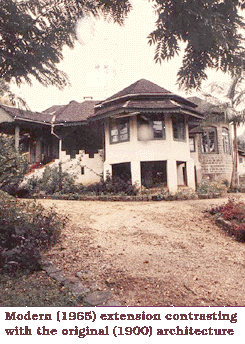

![]()
The Radella bungalow is renowned in the planting fraternity for having on its doorstep a cricket field that is a venue that has greatly impressed visiting teams. There are plans to raise this playing ground of the Dimbulla Athletic and Sports Club to international standards. So we expected the bungalow to be special.
Perhaps once it was. Alas, due to architectural zeal (or ignorance), in 1965 its grand design was distorted with an annexe that, 30 years later, seems clumsy and hideous.
The records show that the original bungalow was built, at a cost of
Rs. 42,285/78 in 1900. That was the year that the intrepid Henry W. Cave
wrote in Golden Tips, his book on Ceylon tea and railways: "If we
stand upon the railway line we shall obtain  a
view of the Radella race course. A curious and unique feature will be noticed
in the rows of tea bushes which cover the ground within the course."
a
view of the Radella race course. A curious and unique feature will be noticed
in the rows of tea bushes which cover the ground within the course."
Even today the rail journey is enchanting. The bungalow lies just over eight miles from Talawakele station and four miles from Nanu Oya station. After the British-named Great Western station at 5,295 feet above sea level, the train's progress through the hills is so slow and stately you feel you can rech out and pluck tea yourself. Radella has its own station, dedicated to tea.
The race course has been ousted by the cricket field and tea grows up to its boundaries, no longer within its circle. With binoculars you could have a distant view of a match from the verandah of the Radella bungalow.
The first glimpse of the bungalow as you approach along its drive is confusing. It has the deep pitched wooden shingle roof of a classic turn-of-the-century granite block building, but with a monstrous stucco-daubed rotunda tacked onto its side. Fortunately, the roof of this eyesore has wooden shingles too.
What seems so jarring to the eye is that, because of the height of the bungalow above the ground, the rotunda has been built on concrete pillars. Fair enough, but no attempt has been made to hide them from view. A simple hedge would have done the job. And the white-painted pebble dash of its walls is so out of place against the solemnity of the granite of the original building.
However, since this is the renowned Radella plantation house we entered it with hope that the interior of the bungalow would soothe the shock of its exterior countenance. It was not to be. The morning room created by the rotunda is really quite insignificant and one wonders why, in 1965, it was thought necessary to add the extension.
There have been other changes over the years with the dining room no longer in its original location. Since the kitchen and servants' quarters are in a separate building reached by a lower floor passage, the move could have been one of convenience.
Naturally, given its altitude of 5,000 feet above sea level, the bungalow has fireplaces, one being quite spectacular. Now painted white it has pew sides and halfmoon stone hobs at either side of its grate. It contrasts aesthetically with the darkly polished boards of the room's wooden floor.
Delving into recesses we discovered furniture typical of the heydays of planting. An example is the wooden office chair, with hard wooden seat sculpted to fit the contours of a planter's buttocks, and a swivelling mechanism suitably cranky.
The total area of the Radella bungalow when it was built was 4,880 square feet. It spreads over different levels, its inner depths composed of bedrooms, bathrooms, corridors and nooks and crannies. It must have inspired a great deal of affection in the hearts of its occupants when a planter and his wife from Britain would have spent years at a time there.
To complement the upgrading of the cricket field, it would be fitting, and not too difficult, to restore Radella to its former magnificence as a noble bungalow too.
Continue to Plus page 4 * Sheer luxury in the jungle
Return to the Plus contents page
![]()
| HOME PAGE | FRONT PAGE | EDITORIAL/OPINION | NEWS / COMMENT | BUSINESS
Please send your comments and suggestions on this web site to
info@suntimes.is.lk or to
webmaster@infolabs.is.lk